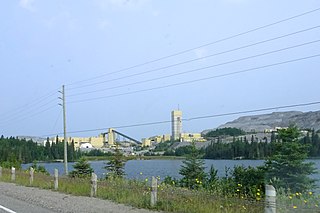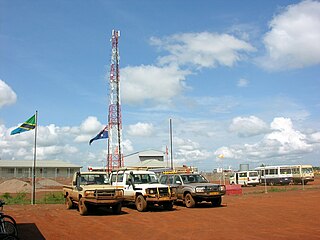Related Research Articles

The economy of Tanzania is a lower-middle income economy that is overwhelmingly dependent on agriculture. Tanzania's economy has been transitioning from a command economy to a market economy since 1985. Although total GDP has increased since these reforms began, GDP per capita dropped sharply at first, and only exceeded the pre-transition figure in around 2007.

Tanzanite is the blue and violet variety of the mineral zoisite, caused by small amounts of vanadium. Tanzanite belongs to the epidote mineral group. Tanzanite is only found in Simanjiro District of Manyara Region in Tanzania, in a very small mining area near the Mererani Hills.

Barrick Gold Corporation is a mining company that produces gold and copper with 16 operating sites in 13 countries. It is headquartered in Toronto, Ontario, Canada. It has mining operations in Argentina, Canada, Chile, Côte d'Ivoire, Democratic Republic of the Congo, Dominican Republic, Mali, Papua New Guinea, Saudi Arabia, Tanzania, the United States and Zambia. In 2019, it produced 5.5 million ounces of gold at all-in sustaining costs of $894/ounce and 432 million pounds of copper at all-in sustaining costs of $2.52/pound. As of 31 December 2019, the company had 71 million ounces of proven and probable gold reserves.

Judith Wambura Mbibo, known by her stage name Lady Jaydee also referred to as "Lady JayDee in town" or "Lady Jay Dee", is a Tanzanian singer. She specializes in the R&B, Zouk and Afro Pop genres. Lady Jaydee was voted Best Tanzanian Female R&B Artist in 2002, performed at the Kora All Africa Designers Competition, and was awarded "Best R&B Album" at the Tanzania Music Awards on 6 August 2004. In July 2005, she won an award for "best female video for South Africa". She was among the first females to sing R&B in Swahili. Lady Jaydee is signed to one of Africa's most successful music labels, Taurus Musik. She is also known as the Queen of Bongo Flava.
Geita is a town and regional capital of Geita Region in northwestern Tanzania. The town is known for its gold trade. Geita, with a population of 99,795. It is located in the centre of a gold mining area. In March 2012 it became the administrative headquarters of the newly created Geita Region.

Geita District is located in the Geita Region of Tanzania. According to the 2012 census, the population of the district was 807,619. The district is bordered to the east by Mwanza Region and Nyang'hwale District, to the south by Shinyanga Region and Mbogwe District, and to the west by Chato District.

The Geita Gold Mine is an open pit gold mine located in the Geita District of the Geita Region of Tanzania. It is operated by AngloGold Ashanti.
Acacia Mining is a gold mining business operating in Tanzania, with exploration properties in Kenya, Burkina Faso and Mali. It is listed on the London Stock Exchange and the Dar es Salaam Stock Exchange and is a constituent of the FTSE 250 Index until it was re-acquired by Barrick Gold in September 2019.
The Sekenke Gold Mine was an underground gold mine in the Singida Region of Tanzania.
Tulawaka Gold Mine was a combined underground and open pit gold mine located in the Biharamulo district, in the Kagera Region of Tanzania. It is operated by African Barrick Gold, who owned 70% of the mine. The remaining 30% was owned by MDM Mines.
Bulyanhulu Gold Mine is an underground gold mine in the Shinyanga Region of Tanzania, located 55 kilometres south of Lake Victoria. It is one of three gold mines owned by Acacia Mining plc, formerly African Barrick Gold plc, a company owned by Barrick Gold, which is listed on the London Stock Exchange, and operates in Tanzania. Acacia also owns Buzwagi Gold Mine and the North Mara Gold Mine.

Buzwagi Gold Mine is an open pit gold mine in the Shinyanga Region of Tanzania, located 6 kilometres southeast from the town of Kahama. It is operated by Acacia Mining.
North Mara Gold Mine is a combined open pit and underground gold mine in the Tarime District of the Mara Region of Tanzania. It is one of three gold mines of Acacia Mining plc, a company listed on the London Stock Exchange, that operates in Tanzania, the other two being Bulyanhulu and the Buzwagi Gold Mine.
The Golden Pride Gold Mine is an open pit gold mine located in Nzega District of the Tabora Region of Tanzania. It is operated by Australian mining company Resolute Mining.
This lists of mines is a meta-list containing links to mine-related lists.

Geita Region is one of Tanzania's 31 administrative regions. The region covers an area of 20,054 km2 (7,743 sq mi)."Geita Region Size". The region is comparable in size to the combined land area of the nation state of Slovenia. Geita Region is bordered to the east by Lake Victoria, Mwanza Region and Shinyanga Region. The region is bordered by Tabora Region and Kigoma Region to the south and south west respectively. Lastly, Gieta is borders Kagera Region to the west.
The Lupa Gold Field is an area of about 2,600 square kilometres (1,000 sq mi) in south west Tanzania, north of Mbeya, that is known for its gold deposits. European mining is believed to have started after alluvial gold was found in water drawn from the Lupa River, near Lake Rukwa. Lode mining began in 1934 at Ntumbi and in 1939 at New Saza.
The New Luika Gold Mine is an active mine in the Lupa Gold Field, an area of about 2,600 square kilometres (1,000 sq mi) in south west Tanzania, north of Mbeya, that is known for its gold deposits. It is the principal mine of Shanta Gold and saw its first gold pour in August 2012.

Tanzania is a land rich in minerals. Mining makes up more than 50% of the country's total exports, of which a large part comes from gold. The country has gold reserves of 10 million ounces, generating revenue of over a billion USD. Diamonds are also found in significant amounts. Since it was opened in 1940, the Williamson diamond mine has produced 19 million carats (3,800 kg) of diamonds. Gemstones, nickel, copper, uranium, kaolin, titanium, cobalt and platinum are also mined in Tanzania. Illegal mining and corruption are ongoing problems. In 2017, the government passed a series of bills aimed at increasing revenue from minerals after a scandal which caused the dismissal of the Minister for Energy and Minerals.
References
- 1 2 3 "Tanzania minerals" (PDF). eiti.org. 2013. Retrieved 2013-06-24.